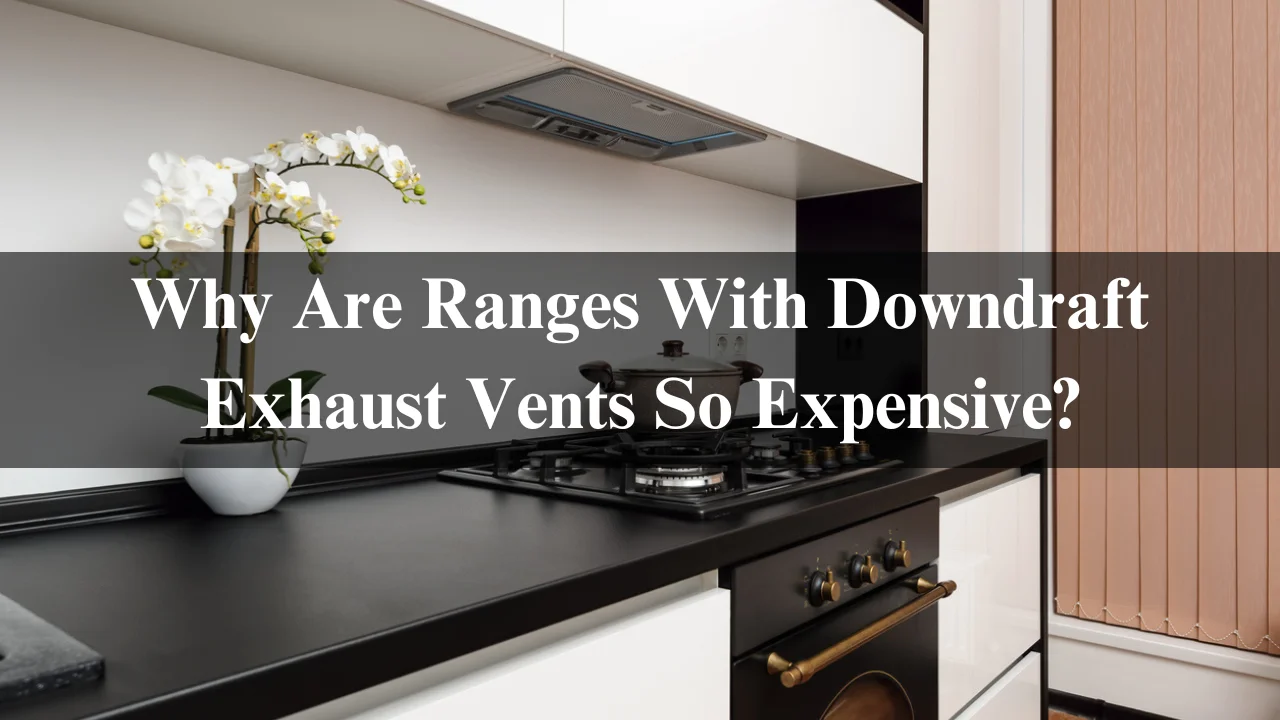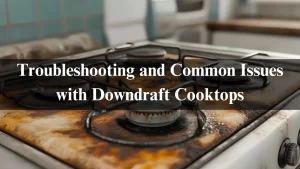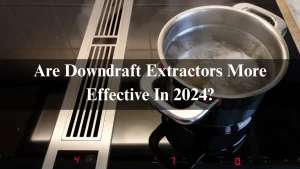Are you considering upgrading your kitchen with a sleek downdraft range? If so, you’ve probably noticed that these modern appliances have a price tag that can make your heartbeat. But what makes them so expensive compared to traditional ranges?
Let’s dive into the world of downdraft exhaust systems and uncover the reasons behind their elevated costs. Whether you’re all about functionality or style, understanding this appliance could change how you view your cooking space forever!
Table of Contents
Why do Downdraft Ranges Come with a Hefty Price Tag?
Downdraft ranges often carry a higher price tag due to their specialized design and technology. Unlike standard ranges, they integrate an downdraft exhaust system that pulls smoke and odors downwards. This unique feature requires advanced engineering.
The materials used in downdraft ranges also contribute to the cost. Many models are constructed from high-quality stainless steel, ensuring durability and a modern aesthetic. These premium materials not only enhance performance but elevate kitchen style.
Installation complexity is another factor driving up expenses. Downdraft systems need proper ductwork, which can lead to additional labor costs during installation.
These appliances often come equipped with smart features such as touch controls or connectivity options for seamless user interaction, further adding value—and expense—to your purchase decision.
What Exactly Is a Downdraft Range?
A downdraft range is a modern cooking appliance that blends the functionality of a traditional stove with an integrated ventilation system. Unlike standard ranges, which typically rely on overhead hoods to capture smoke and odors, downdraft models pull air downward.
This innovative design features vents located at the back or side of the cooktop. When you turn on your burners, these vents activate and draw smoke away from food right where it’s produced. The air is then filtered and expelled outside or recirculated within the kitchen.
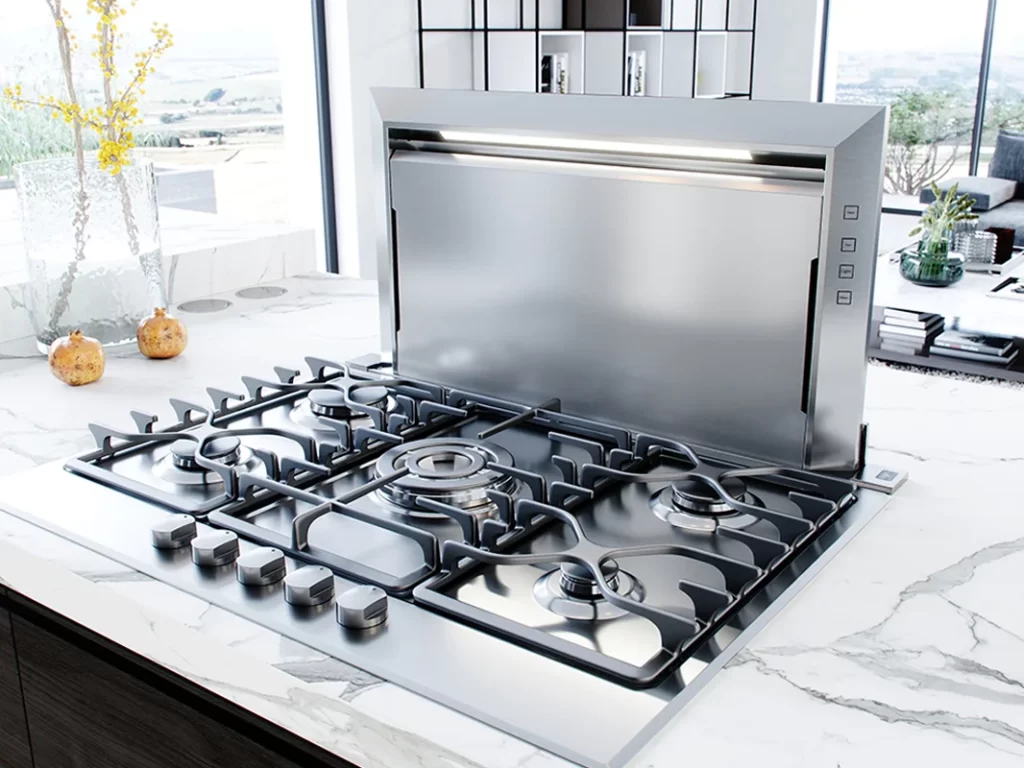
Downdraft ranges are especially popular in open-concept spaces where conventional venting isn’t feasible. Their sleek appearance allows for unobstructed sightlines while maintaining effective ventilation. For those looking to combine aesthetics with performance, downdraft exhaust systems offer a unique solution that caters to both needs effectively.
Why do the downdraft ranges differ from traditional ranges?
Downdraft ranges stand apart from traditional models primarily due to their innovative ventilation systems. Instead of a bulky hood overhead, they feature a built-in downdraft exhaust vent that pulls smoke and odors downwards. This design allows for more flexibility in kitchen layouts.
The aesthetic appeal is another factor. Downdraft ranges can seamlessly blend into modern kitchens without the visual clutter of an overhead hood. Homeowners appreciate this streamlined look.
Performance also varies significantly. Traditional ranges may struggle with proper ventilation, leading to lingering smells and smoke during cooking sessions. In contrast, downdraft systems efficiently capture emissions at the source, ensuring cleaner air in the kitchen environment.
These ranges often come equipped with advanced features like adjustable fan speeds and additional filtration options, enhancing their overall functionality compared to standard alternatives.
When Were Downdraft Ranges Introduced?
The downdraft range debuted in kitchen appliance marketing in the late 1970s. This innovation was born from a desire for better ventilation solutions that complemented contemporary open-concept living spaces.
As cooking styles evolved, so did the need for effective exhaust options. Traditional overhead hoods clashed with sleek designs and aesthetics. Downdraft systems offered a stylish alternative. They integrated seamlessly into countertops or stovetops, eliminating bulky hoods that obstructed views.
The early models were simple yet effective, capturing smoke and odors right at the source. Over time, manufacturers refined their functionality and design features to meet consumer demands for efficiency and style.
This evolution reflects changing lifestyles where kitchens became central gathering spaces rather than just functional areas. The downdraft range continues to adapt as technology advances, ensuring it remains relevant in modern culinary settings today.
What is the advance technology behind the downdraft range?
When exploring the advanced technology behind downdraft ranges, it’s essential to understand their innovative design. These appliances incorporate a built-in ventilation system that captures smoke and odors directly at the cooking surface. Unlike traditional hoods, which are typically mounted overhead, downdraft exhaust systems pull air downward and vent it outside through ducts or filters.
This technology often includes powerful fans capable of effectively removing steam and heat from your kitchen environment. Some models even feature sensors that automatically adjust fan speed based on the level of cooking activity, ensuring optimal performance without constant manual adjustments.
Additionally, many downdraft ranges use high-quality materials designed for durability and easy cleaning. They may also come with integrated controls for added convenience. The result is an aesthetically pleasing appliance that enhances functionality while maintaining a sleek appearance in modern kitchens.
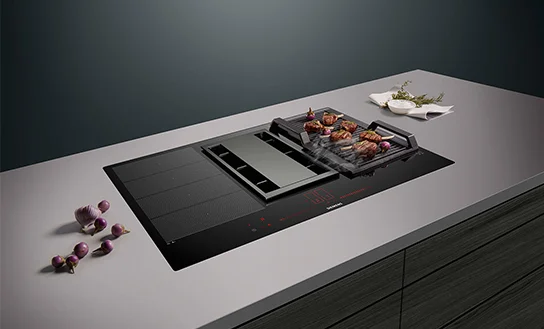
The combination of these features contributes significantly to their higher price point compared to standard ranges. Investing in a downdraft range means choosing efficiency and style over conventional designs—a decision that can dramatically transform your cooking experience and kitchen aesthetic.
Why Do Downdraft Ranges Cost So Much?
Downdraft ranges are more than just cooking appliances; they blend innovation and design. One primary reason for their higher cost is the advanced technology involved in their ventilation systems. Unlike traditional hoods, downdrafts pull smoke and odors downward, which requires sophisticated engineering.
The integration of these downdraft exhaust systems within the range itself presents manufacturing challenges. This complexity often translates into increased labor costs during production.
Additionally, many downdraft models come with premium features such as touch controls, multiple fan speeds, and even smart technology that allows you to control your appliance from your smartphone.
These added conveniences not only enhance user experience but also contribute to the overall expense. It’s clear that investing in a downdraft range means you’re paying for efficiency, aesthetics, and modern functionality all rolled into one elegant package.
What Factors Influence the High Price of Downdraft Ranges?
When it comes to downdraft ranges, several factors contribute to their higher price tag. First and foremost is the technology involved in their design. Downdraft exhaust systems are engineered to efficiently pull smoke and odors downward, which requires sophisticated engineering compared to traditional hoods.
Materials also play a critical role. High-quality stainless steel and durable components enhance both aesthetics and functionality. These materials resist wear over time, justifying the investment.
Another factor is versatility. Many downdraft models combine cooktop features with integrated ventilation options. This dual-functionality means you’re paying for convenience as well as performance.
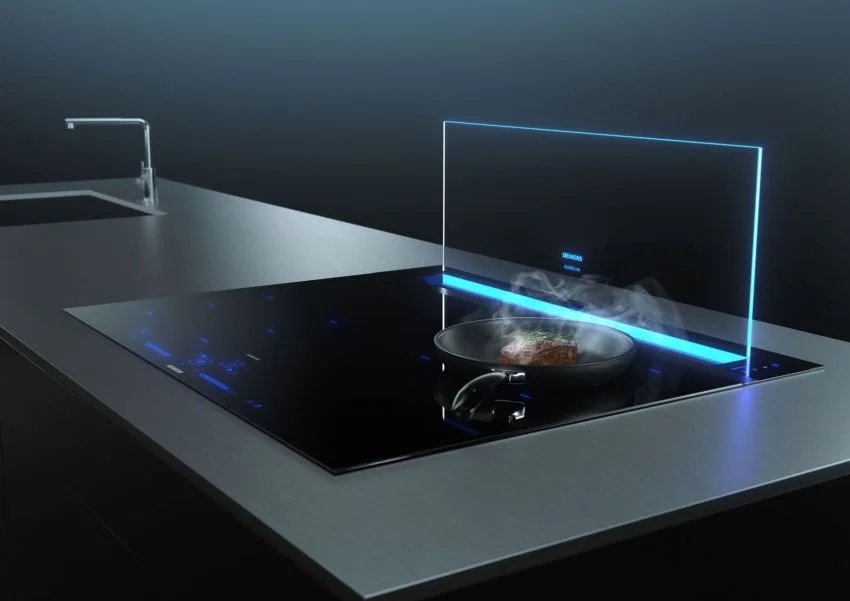
Moreover, brand reputation affects pricing significantly. Established brands often come with warranties and customer support that new or lesser-known manufacturers may not offer, adding perceived value to your purchase.
Energy efficiency standards can drive up costs but ultimately save you money in the long run through reduced utility bills.
What are the main reasons for the higher price of downdraft range?
The main reasons for the higher price of downdraft ranges stem from advanced technology and innovative design. Unlike traditional ranges, these appliances incorporate built-in ventilation systems that efficiently draw smoke and odors downwards. This complexity requires sophisticated engineering.
Materials also play a crucial role in pricing. High-quality stainless steel is often used to ensure durability and aesthetics. Cheaper alternatives just can’t match the longevity or look of premium materials.
Installation can be another cost factor. Downdraft exhaust systems require specific configurations within your kitchen layout, which may lead to additional labor costs during setup.
Brand reputation must be addressed. Premium brands invest heavily in research and development, ensuring their products stand out through superior performance and reliability. This investment reflects directly on your retail price when shopping for a downdraft range.
How do premium parts contribute to both performance and longevity?
Premium parts play a significant role in the performance and longevity of downdraft exhaust ranges. These high-quality components are designed to withstand the rigors of everyday cooking while delivering optimal functionality.
For instance, powerful motors ensure that the downdraft vent efficiently captures smoke, steam, and odors from your cooking area. This efficiency improves air quality and enhances your overall cooking experience. When you invest in premium parts, you’re investing in technology that works seamlessly together to provide consistent results.
Durability is another key aspect associated with higher-priced models. High-end materials resist wear and tear better than their cheaper counterparts. Stainless steel surfaces are more likely to hold up against scratches and stains over time, maintaining their sleek appearance much longer.
Moreover, advanced features such as smart controls or customizable settings often come standard on these models. They offer enhanced user-friendliness and adaptability for various cooking needs. With a focus on innovation, premium designs can elevate both aesthetics and performance within your kitchen space.
When choosing a downdraft exhaust range, it’s clear that spending more upfront may lead to greater satisfaction down the line due to lasting quality and effectiveness—making mealtime less stressful and far more enjoyable.
How Do Downdraft Ranges Compare to Traditional Ventilation Systems?
Downdraft ranges operate differently than traditional hoods. Instead of pulling air upward, they draw smoke and odors down through the cooktop. This unique mechanism can be advantageous in kitchens with limited overhead space.
Traditional ventilation systems often dominate kitchen design, featuring bulky hoods that require significant ceiling height. Downdraft units eliminate this need, allowing for more flexible layouts and open spaces.
Another comparison lies in aesthetics. While conventional vents may disrupt a kitchen’s visual flow, downdraft ranges blend seamlessly into modern designs. They maintain a clean line of sight, enhancing the overall ambiance of your cooking area.
Performance also varies between these systems. Traditional hoods typically offer higher airflow rates but can overwhelm smaller kitchens with their presence. In contrast, downdrafts provide adequate ventilation without overpowering the room’s atmosphere, which is appealing for many homeowners seeking a balance between functionality and style.
Table: Downdraft Ventilation vs. Overhead Ventilation
| Feature | Downdraft Ventilation | Overhead Ventilation |
| Cost | Higher | Lower (but separate purchase needed) |
| Aesthetics | Sleek, minimalistic | Bulky and requires extra space |
| Performance | Effective, but may struggle with heavy fumes | More powerful and efficient |
| Installation | Complex (requires ductwork in cabinetry) | Easier (overhead mounting) |
| Space-saving | Yes (no overhead clearance needed) | No (requires headroom) |
Are Downdraft Ranges Less Effective than Traditional Ventilation?
Many people wonder if downdraft ranges can compete with traditional ventilation systems. The answer isn’t as straightforward as it seems.
Downdraft exhaust works by pulling smoke and odors down through vents in the cooktop. This design allows for a streamlined appearance, but some argue it may not capture all cooking fumes as effectively.
Traditional hoods are more powerful, designed to remove air directly above the stove. They create a strong airflow that can quickly clear out heat and grease from your kitchen.
However, effectiveness can depend on various factors like cooking methods and kitchen layout. If you’re an occasional home cook or prefer simple meal prep, a downdraft range might meet your needs just fine without overwhelming aesthetics.
Personal preference plays a significant role in determining what’s best for you and your space.
What Are the Benefits of a Downdraft Range?
A downdraft range offers several benefits that appeal to modern homeowners. One of the most significant advantages is its space-saving design. These ranges can fit seamlessly into kitchen layouts without bulky hoods, making them ideal for smaller spaces.
Their sleek and modern aesthetics enhance any kitchen decor. A downdraft exhaust system integrates beautifully, providing a clean look without compromising style.
Flexibility is another key benefit. Downdraft ranges allow for versatile kitchen designs and configurations, enabling you to position your cooking area away from exterior walls or windows. This adaptability opens up creative possibilities in your culinary space.
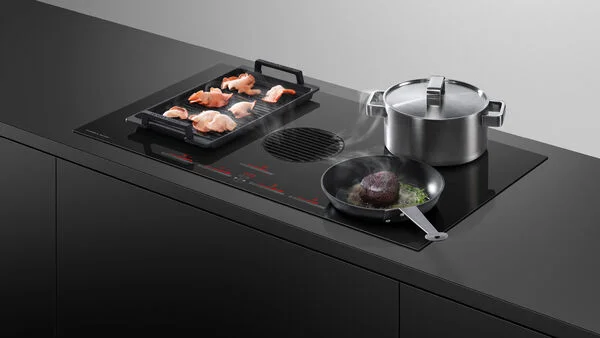
Moreover, integrating the ventilation directly into the range means less noise than traditional installations. The quiet operation ensures a more pleasant cooking experience while maintaining effective air quality throughout your kitchen environment.
Are There Any Drawbacks to Downdraft Ranges?
While downdraft ranges offer a sleek design and space-saving features, they aren’t without their drawbacks. One significant concern is ventilation efficiency. Unlike traditional hoods that capture steam and smoke rising from cooking, downdraft exhaust systems may struggle during heavy cooking sessions.
Another issue is the placement of the vent itself. If it’s not positioned correctly, it can be less effective at capturing odors and grease. This can lead to lingering smells in your kitchen.
Maintenance also becomes a factor. Downdraft vents require regular cleaning to ensure optimal performance. The mechanisms can accumulate debris over time, which might necessitate professional servicing more often than traditional range hoods.
These factors are important to consider when weighing your options for kitchen appliances.
Less Effective Ventilation for Heavy Cooking
Downdraft exhaust systems are designed to pull smoke and odors down through the cooktop. While this may work well for everyday cooking, it can struggle under heavy use.
When frying or searing foods at high temperatures, the amount of steam and smoke generated can overwhelm a downdraft vent. This often leads to lingering odors in your kitchen.
Traditional hoods typically have higher airflows and better capture capabilities. They can easily handle intense cooking scenarios without issue.
Another factor is placement. Downdraft vents are usually located at the back of the range, which might not efficiently capture all emissions compared to overhead models closer to the source.
For those who love heavy-duty cooking, relying solely on a downdraft system might fall short of expectations when it comes to maintaining air quality during culinary adventures.
Higher Installation and Maintenance Costs
Installing a downdraft range requires more than just placing it in your kitchen. The complex ventilation system often demands professional installation, driving up initial costs.
Unlike traditional ranges that may vent directly outside, downdraft systems usually need customized ductwork. This added complexity can lead to unexpected expenses.
Maintenance is another consideration. Downdraft vents accumulate grease and debris, requiring regular cleaning to function properly. Neglecting this upkeep can affect performance over time.
Replacement parts might also be pricier due to the specialized nature of these units. Homeowners should budget for both immediate installation costs and ongoing maintenance needs when opting for a downdraft exhaust solution.
The investment isn’t just about the purchase price; it’s about ensuring long-term functionality and efficiency as well.
Are Downdraft Ranges Worth the Investment?
Investing in a downdraft range can seem daunting due to the higher price tag. However, this appliance offers unique features that may justify the costs of many homeowners.
Downdraft ranges combine cooking and ventilation seamlessly. They eliminate the need for bulkier overhead hoods. This saves space, making them ideal for kitchens with limited room or open floor plans.
Additionally, their sleek design adds a modern touch to your kitchen decor. If aesthetics matter to you, this could be a significant perk.
Moreover, they are designed to work well with various cooktops, including induction and gas options. This versatility enhances your cooking experience while maintaining effective ventilation at lower levels.
For those who prioritize functionality and style in their culinary spaces, investing in a downdraft is worth it. The convenience these appliances offer often outweighs the initial sticker shock for avid home cooks.
Who Should Consider a Downdraft Range?
Downdraft ranges are ideal for open kitchen layouts. If your space merges seamlessly with dining or living areas, a downdraft model can maintain aesthetics without bulky overhead hoods.
They suit individuals who prioritize style over traditional ventilation. Many models offer sleek designs that enhance modern kitchens while providing necessary functionality.
Home chefs who refrain from heavy frying or grilling will find them sufficient. Light cooking often produces less smoke and steam, making downdraft systems effective for everyday use.
If you’re limited on ceiling height or have structural restrictions, these ranges offer flexibility where conventional options might not fit. They solve the problem of venting without needing extensive modifications to your home’s structure.
If you value convenience and easy cleaning, a downdraft range simplifies maintenance compared to larger vent hoods that gather grease over time.
What Are Some Popular Brands Offering Downdraft Ranges?
When considering a downdraft exhaust range, it’s also essential to look at the brands that offer these specialized appliances. Several manufacturers have made a name for themselves in this niche market.
Bosch is renowned for its high-quality kitchen appliances. Their downdraft ranges combine sleek design with efficient performance. Another popular choice is KitchenAid, which offers a variety of models featuring powerful ventilation systems and stylish finishes.
Samsung has entered the arena as well, providing innovative technologies alongside their downdraft options. They focus on modern aesthetics and functionality that appeal to today’s homeowners.
Whirlpool remains a staple in many kitchens worldwide. Their downdraft ranges are designed with practicality while maintaining affordability without sacrificing quality.
Electrolux adds luxury into the mix, offering premium features that cater to serious home chefs looking for top-tier performance from their cooking equipment.
These brands demonstrate different aspects of what you can expect when investing in a downdraft exhaust range. Whether your priority is style, efficiency, or cutting-edge technology, there’s likely a brand tailored just for you.
Related Articles:
Do downdraft cooking vents work? Latest Update 2024
Are Cooktops With Integrated Downdraft Ventilation Any Good?
How Effective Are Downdraft Vents In The Kitchen? 2024
Are Downdraft Extractors More Effective In 2024?
Conclusion
In conclusion, downdraft ranges have a higher price tag due to their advanced engineering, premium materials, and integrated ventilation systems. They offer sleek design and flexibility but can have higher installation and maintenance costs compared to traditional ventilation options. While downdraft ranges might not be as powerful as overhead hoods for heavy-duty cooking, they provide a modern and efficient solution for those looking to balance functionality with aesthetics in their kitchen design.
FAQs
Is a downdraft range worth the cost?
Yes, a downdraft range is worth the investment for homeowners who value aesthetics, space efficiency, and flexibility in kitchen design.
Can I install a downdraft range in any kitchen?
Installation can be complex and requires ducting beneath the floor or cabinetry, so it may only be suitable for some kitchens with major renovations.
Do downdraft ranges perform as well as overhead ventilation?
For light to moderate cooking, they work well. However, they may struggle with heavy fumes and large kitchens.
What are the long-term benefits of downdraft ranges?
They offer more flexibility in kitchen layout, save space, and provide a sleek, modern appearance that can increase home value.

